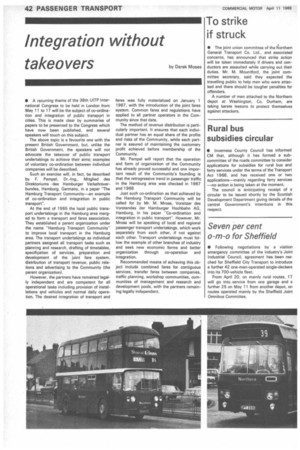Integration without takeovers
Page 44

If you've noticed an error in this article please click here to report it so we can fix it.
by Derek Moses • A recurring theme of the 38th UITP International Congress to be held in London from May 11 to 17 will be the subject of co-ordination and integration of public transport in cities. This is made clear by summaries of papers to be presented to the Congress which have now been published, and several speakers will touch on this subject.
The above topic is a favourite one with the present British Government, but, unlike the British Government, the speakers will not advocate the takeover of public transport undertakings to achieve their aims; examples of voluntary co-ordination between individual companies will be described.
Such an exercise will, in fact, be described by F. Pampel, Mitglied des Direktoriums des Hamburger Verkehrsverbundes, Hamburg, Germany, in a paper "The Hamburg Transport Community—an example of co-ordination and integration in public transport".
At the end of 1965 the local public transport undertakings in the Hamburg area merged to form a transport and fares association. They established a parent organization under the name "Hamburg Transport Community" to improve local transport in the Hamburg area. The transport undertakings as individual partners assigned all transport tasks such as planning and research, drafting of timetables, specification of services, preparation and development of the joint fare system, distribution of transport revenue, public relations and advertising to the Community {the parent organization).
However, the partners have remained legally independent and are competent for all operational tasks including provision of installations and vehicles and normal daily operation. The desired integration of transport and fares was fully materialized on January 1 1967, with the introduction of the joint fares system. Common fares and regulations have applied to all partner operators in the Community since that date.
The method of revenue distribution is particularly important. It ensures that each individual partner has an equal share of the profits and risks of the Community, while each partner is assured of maintaining the customary profit achieved before membership of the Community.
Mr. Pampel will report that the operation and form of organization of the Community has already proved successful and one important result of the Community's founding is that the retrogressive trend in passenger traffic in the Hamburg area was checked in 1967 and 1968 Just such co-ordination as that achieved by the Hamburg Transport Community will be called for by Mr. M. Mross, Vorsitzer des Vorstandes der Hamburger Hochbahn AG, Hamburg, in his paper "Co-ordination and integration in public transport", However, Mr. Mross will be speaking of local and regional passenger transport undertakings, which work separately from each other, if not against each other. Transport undertakings must follow the example of other branches of industry and seek new economic forms and better organization through co-operation and integration, Recommended means of achieving this object include combined fares for contiguous services, transfer fares between companies, traffic planning, workshop communities, communities of management and research and development pools, with the partners remaining legally independent.












































































































































